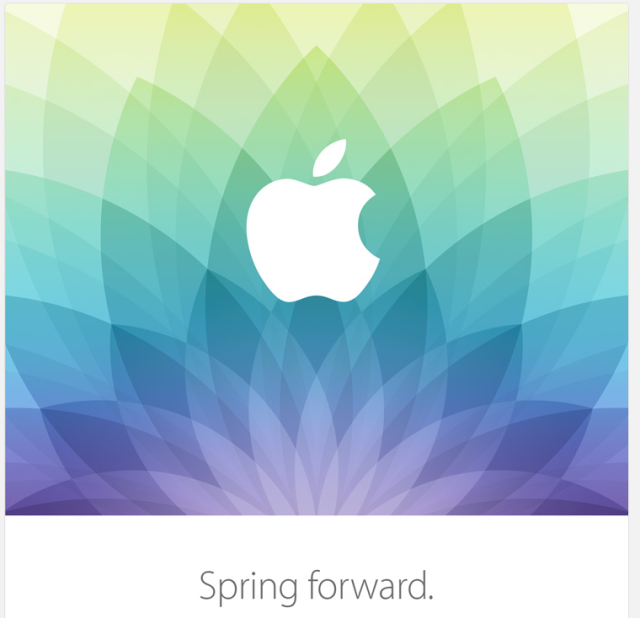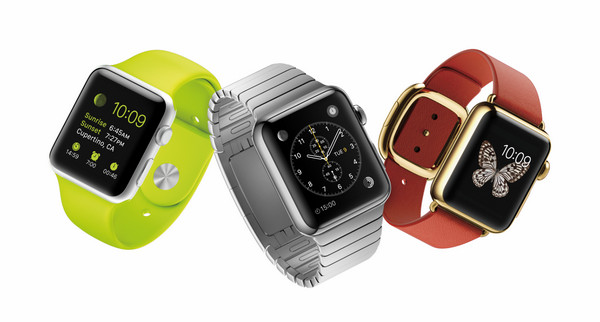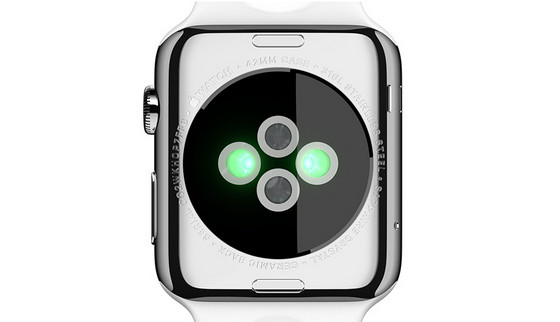Apple has recently sent out e-mail invitations to reporters and others to attend it’s “Spring Forward” media event, which is scheduled to take place on March 9, 2015 Pacific Time, according to a caijing.com report.
 |
|
Apple's invitation logo for the Spring Forward media event next week. (All Photos Courtesy of Apple) |
Apple Watch features, retail price and launch date will be under the lime light at the event.
The sapphire-screened watches are estimated to cost at least US $ 349 for the basic sports model. Citigroup analyst Jim Suva has placed estimations for the Apple Watch models at modest $350, $550 and $950 for the three different models.Investment firm Piper Jaffray, though, has placed prices at a higher end of $450 for the basic Apple Sport model, and at least $ 7,500 for the luxrious gold version. On the extreme end, PC Pro report, even boldly estimated the 18K gold Apple Watch Edition a hefty price tag of $ 10,000, due to the current gold prices.
 |
|
Left to right: Apple Sport, Apple Watch, and Apple Watch Edition models. Current price estimations for the luxrious Apple Watch edition range from US$ 950 to US$ 10,000. |
Strong sales of the Apple Watch could become music to the ears for China’s sapphire manufacturers.
Up to 40% of Apple Watch will be equipped with sapphire substrate covers that will be supplied by Chinese manufacturer Biel Crystal, analysts estimated. If manufacturers improve sapphire cover yield rates, sapphire usage in Apple Watch could be further scaled up. Sapphire might have been abandoned by the iPhone 6, but it has become the favored material on the Apple Watch. With Chinese Apple sapphire supplier Lens Technology becoming listed on the Chinese bourse, could sapphire’s second growth phase be just around the corner?
According to Apple, there will be 18 styles for the stainless steel Apple Watch series, while the Watch Edition will have six. Each watch comes with four sapphire lenses, infrared, and LED sensors for heart rate measurement. The watch will also come with a gyroscope, accelometer, and will be compatible with iPhone’s GPS and WiFi systems. The watch will be capable of tracking daily activities and users can personalize specific targets and rewards. The power charger on the back of the watch uses Apple’s Magsafe solution for seamless power connections.
 |
|
Four sapphire cover glass are also used on the back of the Apple Watch to protect the LED sensors on the back. Consumer electronic applications, as seen here could stimulate growth in the sapphire industry. |
Consumer electronic applications are the driving force behind sapphire industry growth
Speculations of sapphire stocks began in November 2013, when GT Advance Technology signed a five-year sapphire supply agreement worth US $578 million with Apple.
Even after GTAT declared bankruptcy and terminated the partnership agreement with Apple, there were still market rumors that the Cupertino company was expanding its sapphire patent portfolio. Apple’s latest sapphire screen patent application was approved last month. The new patents will help Apple maintain its leading position in sapphire display materials. In the patent, Apple explained in detail several sapphire applications in consumer electronic devices including sapphire lens for iPhone cameras and the phone display.
“Consumer electronic applications have generated new room for growth in the sapphire industry,” said an Orient Securities analyst that declined to be named. Based on global smartphone shipment estimations of 1.66 billion in 2016, market penetration for sapphire applications in smartphone lenses could reach 80%, home buttons 25%, and 15% for smartphone displays. Thus, the industry could create US $5 billion market value, which would be more than five times of that for the LED substrate material market.
Industry experts have observed LED and smartphone market’s sapphire demands have grown, and eased oversupply sapphire ingot situation from the past few years. It is estimated by 2014, smartphones and other mobile devices sapphire ingot demands will quadruple from 5% to 20%.
 |
|
A Apple Watch with a stainless steel watch band. |
Top Chinese sapphire suppliers recent development
TDG’s monthly sapphire production capacity for 4-inch substrates for LED applications has reached 25,000 per month. The company has 220 sapphire crystal growth furnaces, which are all 90 kg grade furnaces. It recently succeeded in manufacturing a 200 kg grade sapphire crystal from one of its 200Kg grade furnaces, and is in the process of growing the second crystal. It is possible that the company will be scaling up 200 kg grade sapphire manufacturing and purchasing more furnaces, if the second crystal quality meets standards. The 370 sapphire crystal growth furnaces to be added in its factory in Yinchuan will be targeting large-sized crystals.
Roshow Technology
In 2014, Roshow Technology and Biel Crystal announced a joint venture program and set up Biel Roshow Sapphire. Roshow and Biel invested RMB 200 million and RMB 300 million, respectively into the joint venture. Biel Roshow will also be procuring in total 200 sapphire crystal furnaces, all 80 kilogram (kg) grade, from Roshow Technology’s Zhejiang subsidiary. The 80 kg grade sapphire furnaces will be deployed for manufacturing.
Southwest Pharmaceutical
In August 2014, Aurora Optoelectronics Technology (Aurora) and Southwest Pharmaceutical completed a capital transaction, and finished listing on the market. Aurora is mainly a sapphire ingot and material manufacturer, and is also a developer of single crystal growth furnaces. The company has expanded its business strategy from being a sole sapphire ingot manufacturer to sapphire substrates, and is now venturing into the single crystal equipment industry. The company is capable of mass producing 2-inch, 4-inch, 6-inch and above sapphire ingots. It is the world’s major 4” sapphire ingot supplier, and is a supplier for Lens Technology, and Biel Technology.
Hans Laser: The company started selling sapphire cutting equipment in 2014. Most of the company’s sapphire cutting equipment orders in 3Q14 were for Apple Watch display production. Following Apple Watch’s mass production in 2015, Hans Laser’s sapphire cutting equipment will reach 400, and generate an estimated RMB 1.2 billion revenue, according to industry experts.
Zhejiang East Crystal Electronic (ECEC): The company has invested RMB 1.2 billion in two new subsidiaries in Zhejiang Province and Huangshan, China. The company is also cooperating with a Korean company to establish a new subsidiary there. The three subsidiaries will be rolling out LED projects through several phases. ECEC recently revealed on an Internet platform that it is testing the new products, which have entered the phase of client certification, and moving closer to mass production stage.
Crystal Optech
Affected by strong LED downstream demands, there has been tightened Patterned Sapphire Substrate (PSS) supply. As a result, Crystal Optech’s PSS products profitability have improved and spurred high growth rates. The company announced it would be investing RMB 586 million in sapphire ingot, and expanding related projects, which has become one of its major investment plans. The company has constructed a 4-inch PSS production line for LED applications. The company produces annually 24 million sapphire substrates, and 2.5 million millimeter of sapphire ingots (based on 2-inch substrate calculations) from its 80 kg grade sapphire furnaces.
Lens Technology
The company has been listed on the Growth Enterprise Market (GEM) on March 5, 2015. Sapphire production for finger print recognition buttons, and sapphire lens in cameras has reached mass production phase. Sales have been particularly well for both products, the company stated in its investor prospects. In 2013, the company’s annual sapphire revenue reached RMB 1.23 billion. The company supplies its sapphire to major electronic consumer brands including Apple and Samsung that makeup a huge share of the company revenue of 87.65%, 83.60% and 74.15% respectively.















